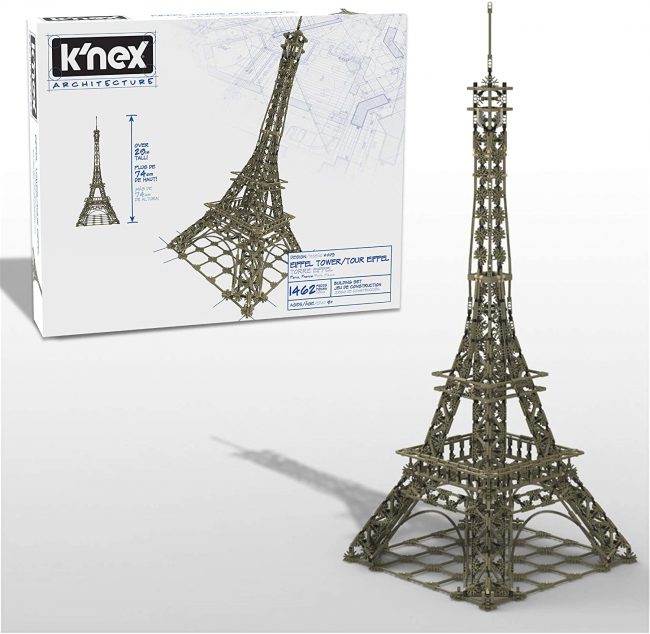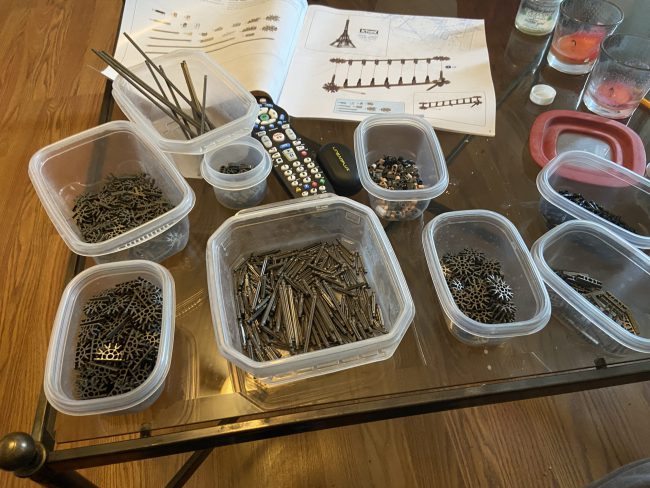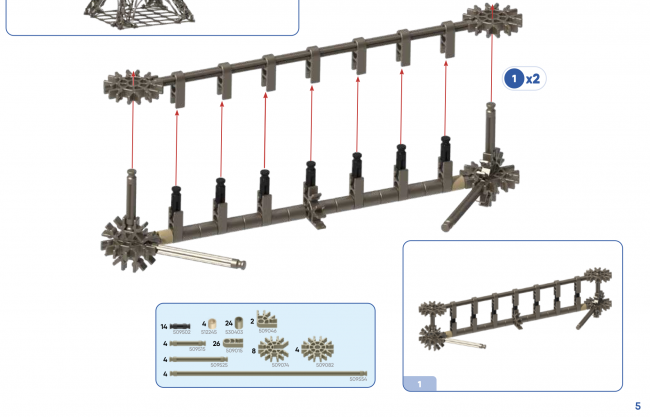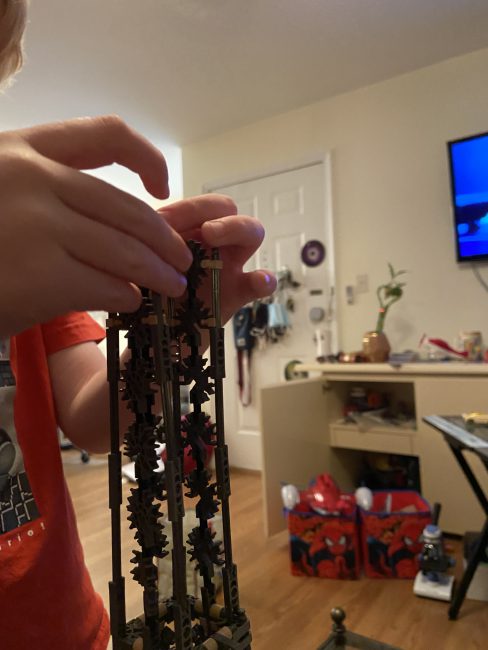There’s a reason I try to wait until I really know a product to do a review — sometimes it takes a little while to grasp what makes something truly succeed or fail. If you asked me three weeks ago what my son and I thought of the K’Nex Architecture Eiffel Tower, you’d want to duck immediately. Now? We can’t wait for more!

This love-hate attitude towards the project has nothing to do with the poor Eiffel Tower itself, which is innocent, despite my grumbling about how it existed solely to spawn a K’Nex kit that was haunting me. And again, I want to emphasize upfront: as much as we hit all kinds of issues, the end result was worth it. As we snapped the final pieces in last night and carefully cleared space for the finished project, my son asked, “So, what’s the next big one we’ll make?” For us, the frustration was worth it, but there were definitely a few moments of “Don’t repeat ANYTHING that just came out of my mouth to your friends at school.”
Admittedly, I’ve never worked with K’Nex before, so some of the learning curve came from getting a sense of how they lay out their instructions and how their pieces function in harmony. Every building set has its own quirks and styles, and once you know that, it lowers many obstacles to future projects. Some, like Lego, give you every single step with fairly detailed pictures. Then you have those mini-blocks of famous monuments, which break down a 600 piece model into just 6 steps, leaving you to squint and count carefully as you find homes for 100 pieces at a time and pray you don’t lose any dot-sized blocks. K’Nex falls somewhere between those two. There’s 40 steps in total and 1,462 pieces to make a 2.5 foot tall Eiffel Tower replica, so while there’s a fair amount of detailed instruction, you’re also working with a lot of pieces in some of the steps.

I tend to over-organize when a project is this complicated, and while it took a bit of time to get organized, I am very glad I did. The pieces all come in a few plastic bags, but they’re jumbled together, and many of them look similar in either size or design. To make my life easier, I sorted them into several containers based on size and design. That way, when a step called for 12 of the short straight connectors, 4 wheels with a bite out of them, and 8 tiny black connectors, I could easily go to each of my carefully sorted containers and find what I needed. If I had to complain about anything regarding the packaging, it would be that it would be nice if the pieces shipped pre-sorted like this because with a project this large, it took a while to break out each piece’s inventory. In addition, some of the straight connector pieces were similar in size. While the steps do take the time to label each item needed with the inventory number, if they were pre-sorted into bags with the inventory number on the outside, it would have saved some time in the beginning.

My biggest issue stemmed from the pictures provided in each step. While some steps did provide a helpful cross-section for little corners and hidden spots, many of the steps were shown from just one angle. As a result, it became a little bit of a guessing game. Was I supposed to add that connector, so it sat at an angle or straight? Which connection slot did it snap into? I had a few steps where I thought I had it right, only to move on to the next step, or worse, 2 or 3 steps later, and realized I had to backtrack because I had misread the photo and put something in the wrong place. I also hit a point where I was convinced I’d built the pylons for the tower wrong, to the point where I emailed our contact at K’Nex asking where I was messing up; he very helpfully explained that I was actually right on — they used computer models to render the steps, and the model showed how the pylons would look when everything was snapped in, so my weird and totally wrong looking pylons were right in the end.

It sounds like I’m complaining a lot, but there were many fun parts to this. Once my son and I hit a groove, we zipped through a big chunk of the steps in one evening, and after our early troubles, every step felt like the world’s greatest victory. It also became significantly easier to build once the shape of it started to come together — that’s when even the confusing bits became easier because we could puzzle out what it was going to be more quickly. It taught my son about being diligent and following instructions closely, as well as using some logical reasoning to work our way out of spots where we got stuck. And frankly, the entire process was worth it for the look on his face when we snapped in the last piece. He just kept saying over and over, “We built it; we built it!” I’m also deeply impressed with how sturdy it is. Once you snap those plastic pieces together, they stay put, and while I wouldn’t use it as a playset, it is definitely sturdy enough to carefully move it from a table to a shelf without an issue, and I don’t see it falling apart spontaneously.

K’Nex makes three different architecture kits right now; the Eiffel Tower, the London Eye, and the Golden Gate Bridge. They recommend these kits to age 9+, and that seems right to me. My son is 7, and while he could handle the steps with help, there is no way he could have built this alone. Even 9 might be a judgment call, depending on how detail-oriented and patient a kid is with a project this big. I’m 39, and I had to have my girlfriend act as a second set of eyes at one point to make sure I was doing it right! It does make for a fantastic parent/child project, though, and certainly an excellent educational opportunity to foster interest in architecture and the physics of how buildings stay upright. They are also extraordinarily reasonably priced. The Eiffel Tower we built sells for $49.99 as does the Golden Gate Bridge; the London Eye set sells for $59.99. Similar competing “famous monuments” building kits often run close to or over $100, so under $50 is a great deal for a kit with this much complexity. Once you get the rhythm of K’Nex building, it’s a lot of fun!
The K’Nex Eiffel Tower sells for $49.99; you can learn more about it on the K’Nex site, and it Is available for purchase from Amazon [affiliate link] and other retailers.
Source: Manufacturer provided sample
What I Like: Finished product looks phenomenal; Very affordable; Once you get into a rhythm, it’s a lot of fun to build.
What Needs Improvement: Instructions are a little sparse; Better photos or a Youtube video walkthrough would eliminate many frustrations with the building process; Separating parts would make it easier to sort out similar-looking pieces.
